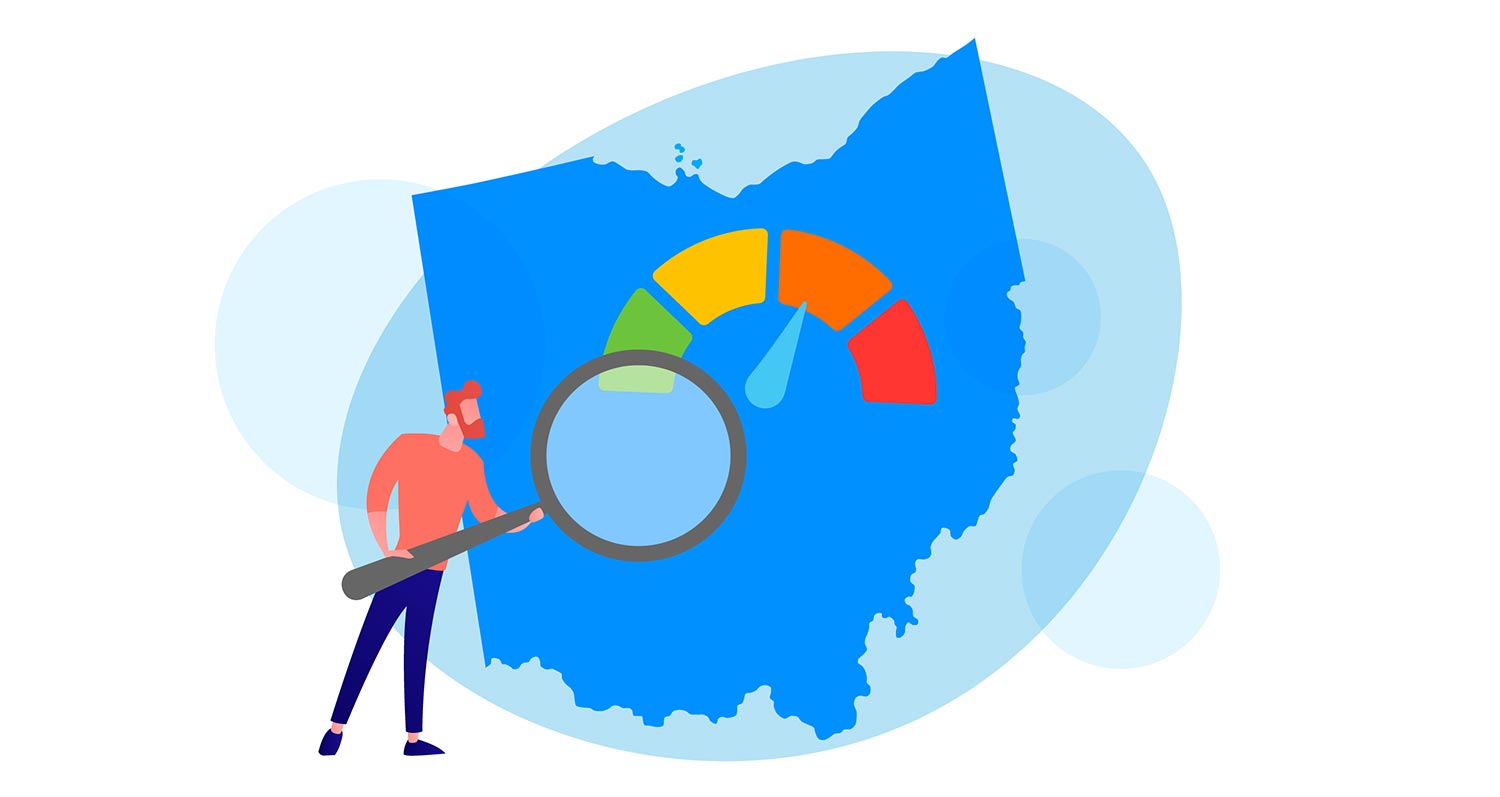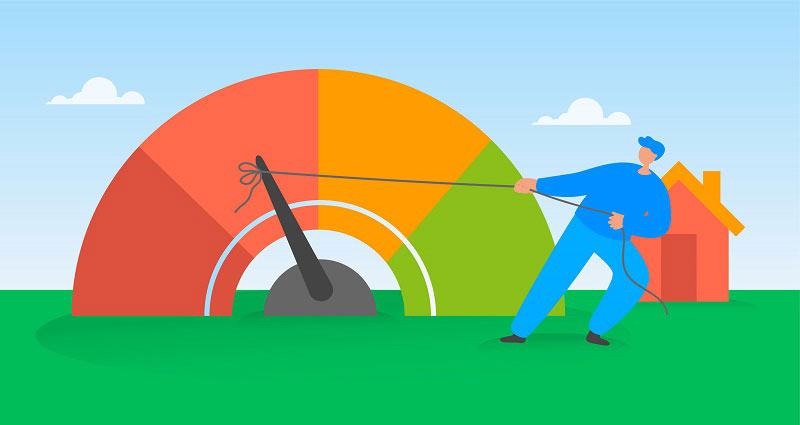
The average Vantage credit score in Ohio is 687. Historically, Ohio has been through the best and worst of the American economy. It was an industrial powerhouse in the early 20th century, and manufacturing remains its largest industry, accounting for more than 18 percent of its GDP.
Unfortunately, the COVID-19 pandemic has delivered a harsh blow, costing the state tens of thousands of manufacturing jobs. [1] COVID-19 has cost Ohio tens of thousands of manufacturing jobs https://www.news5cleveland.com/news/local-news/u-s-secretary-of-labor-visits-northeast-ohio However, even with these challenges, Ohio maintains the third largest manufacturing workforce in the United States. Only California’s and Texas’ are larger. [2] Manufacturing a High-Wage Ohio https://tcf.org/content/report/manufacturing-high-wage-ohio/?agreed=1
While certainly not the nation’s largest or most populated state, Ohio wields the kind of economic and political power that many larger states enjoy. It’s the seventh most populated and the tenth most densely populated state. Consequently, its 11.7 million residents make it a bellwether state for elections—as well as the home state of eight presidents. [3] Ohio Presidents https://www.ohiosos.gov/profile-ohio/people/ohio-presidents/ Buckeyes also power the economic engine of a state that ranks seventh in gross domestic product. [4] Gross Domestic Product of the United States by State https://www.statista.com/statistics/248023/us-gross-domestic-product-gdp-by-state/ But even a state with a powerful economy that has survived many trials is not without its financial problems.
Let’s take a look at how credit and debt affect Ohioans.
Key statistics
- Ohio’s average credit score is 687. The national average is 690.
- Ohio had a 12 percent increase in total consumer debt between 2009 ($341 billion) and 2019 ($383 billion). [9] 2019 Consumer Debt Study (Experian): Debt Reaches New Highs in 2019, but Credit Scores Stay Strong https://www.experian.com/blogs/ask-experian/research/consumer-debt-study/
- The mortgage delinquency rate for the state of Ohio is .92 percent. The average mortgage debt per household is $118,446.
- The unemployment rate in Ohio due to the pandemic reached 17 percent, as of April, 2020.
- The cost of living is 10.7 percent lower in Ohio than the national average. For example, the median price of a home nationally is $231,200. The median home price in Ohio is $140,700. [18] Ohio Cost of Living https://www.bestplaces.net/cost_of_living/state/ohio
- Ohio college graduates carry the eighth highest debt loads, as a percentage of average state income. The average college student who graduates from an Ohio college or university in 2019 had $30,629 in debt. In 2014, the figure was $29,037. [13] Student debt still higher in Ohio than many other states https://www.daytondailynews.com/business/student-debt-still-higher-ohio-than-many-other-states/TWc0IQGdfzBJEhNGrkw75K/
Ohio’s Credit Score Over Time
| Year | Average Vantage Score - OH |
|---|---|
| 2015 | 672 |
| 2016 | 729 |
| 2017 | 697 |
| 2018 | 681 |
| 2019 | 683 |
| 2020 | 687 |
When you compare the average Vantage scores in the United States and in Ohio, the lines consistently overlap. For the past four years, both scores have never been more than a few points off each other; in 2020, the same holds true, within the “good” range between 661 and 780. However, when you look at credit scores regionally within Ohio, the range widens in both directions. For example, Toledo has an average Vantage credit score of 638, which is well below the 661 threshold, putting Toledo in the “fair” range of credit scores. [5] U.S. Cities with the Best & Worst Credit Scores https://lendedu.com/blog/best-credit-score/ According to Experian, this is due to Toledoans having issues with late and missed payments. [7] Study: Toledoans rank average on credit scores https://www.wtol.com/article/news/study-toledoans-rank-average-on-credit-scores/512-8af63641-cdf3-4803-b968-6a82b902eb9b Cleveland has an average Vantage score of 645, also within the fair range. [5] U.S. Cities with the Best & Worst Credit Scores https://lendedu.com/blog/best-credit-score/ However, Akron’s average Vantage score shoots up to 680. [6] Cleveland-Akron consumers have best credit score among Ohio metro areas https://www.cleveland.com/business/2017/01/cleveland-area_consumers_have.html

How to Build Credit When You Have None
Building credit from scratch can be a lot easier when you understand where to start and which mistakes to avoid.
Download our guideHow Credit Scores in Ohio Compare to Other States
| Year | Average Vantage Score - OH | Average Vantage Score - US |
|---|---|---|
| 2015 | 672 | 672 |
| 2016 | 729 | 726 |
| 2017 | 697 | 678 |
| 2018 | 681 | 678 |
| 2019 | 683 | 684 |
| 2020 | 687 | 690 |
Ohio’s average credit score of 687 very closely matches the national average, and its ranking reflects this. Ohio falls right in the middle of the pack. The states falling within a few points in either direction of Ohio’s score are a mixture of Midwestern states (Kansas at 692, Michigan at 692, and Missouri at 685), Western states (Idaho - 700, California - 695, and Wyoming - 694), and Southern states (Texas at 666 and Virginia at 692).
Debt in Ohio
| Year | Average Household Debt - OH | Average Household Debt - US |
|---|---|---|
| 2003 | $29,560 | $33,430 |
| 2004 | $31,600 | $37,290 |
| 2005 | $33,080 | $40,650 |
| 2006 | $34,930 | $45,410 |
| 2007 | $36,430 | $50,170 |
| 2008 | $37,940 | $52,010 |
| 2009 | $36,620 | $49,820 |
| 2010 | $35,290 | $47,410 |
| 2011 | $36,280 | $47,790 |
| 2012 | $35,970 | $47,020 |
| 2013 | $34,760 | $45,310 |
| 2014 | $35,160 | $45,710 |
| 2015 | $46,930 | $46,000 |
| 2016 | $36,100 | $46,950 |
| 2017 | $37,160 | $48,800 |
| 2018 | $37,990 | $50,090 |
| 2019 | $39,450 | $51,580 |
Across the U.S., national consumer debt is becoming an increasingly significant problem every year. Household debt in America rose by $601 billion in the fourth quarter of 2019, or 1.4%, surpassing $14 trillion for the first time. [8] U.S. household debt exceeds $14 trillion for the first time https://www.crainscleveland.com/finance/us-household-debt-exceeds-14-trillion-first-time That being said, Ohio has managed to keep its average total household debt below the national average. And Ohio had one of the smallest increases in total debt between 2009 and 2019 at 12 percent, the 10th lowest in the U. S. [9] 2019 Consumer Debt Study (Experian): Debt Reaches New Highs in 2019, but Credit Scores Stay Strong https://www.experian.com/blogs/ask-experian/research/consumer-debt-study/
Mortgage Debt
| Year | Average Mortgage Debt - OH | Average Mortgage Debt - US |
|---|---|---|
| 2003 | $19,590 | $23,740 |
| 2004 | $21,260 | $26,590 |
| 2005 | $22,250 | $29,230 |
| 2006 | $23,690 | $33,400 |
| 2007 | $24,490 | $37,250 |
| 2008 | $25,550 | $38,490 |
| 2009 | $24,620 | $36,810 |
| 2010 | $23,590 | $35,010 |
| 2011 | $23,080 | $34,200 |
| 2012 | $22,490 | $33,230 |
| 2013 | $21,410 | $31,630 |
| 2014 | $21,200 | $31,520 |
| 2015 | $21,230 | $31,330 |
| 2016 | $20,950 | $31,590 |
| 2017 | $21,500 | $32,940 |
| 2018 | $21,810 | $33,680 |
| 2019 | $22,860 | $34,790 |
Ohio ranks 43rd in the country for the amount of mortgage debt held by its residents. [10] Ohio Debt Relief: Your Guide to State Laws and Managing Debt https://www.lendingtree.com/debt-relief/ohio/ Looking at the graph, Ohio stayed well below the national average for mortgage debt. Even during the Great Recession of 2008 when mortgage debt seemed to be spiking everywhere else, Ohio’s increase was not as steep. One thing certainly working in its favor is a low mortgage delinquency rate of .92 percent. [17] Ohio posts mortgage delinquency rate of 0.92%, study finds https://www.thecentersquare.com/ohio/ohio-posts-mortgage-delinquency-rate-of-0-92-study-finds/article_0da40bb2-1fd4-11eb-877b-1367aebb3b60.html
Because of the CARES Act enacted in the wake of the COVID-19 pandemic, total US mortgage debt is at a 15 year low, and consumers have received additional stimulus funds. However, these are temporary measures that could drive both debt and foreclosures back up once these economic stimulus programs expire. Still, this stimulus is vital for a state like Ohio, which is currently dealing with an unemployment rate in excess of 17 percent. [17] Ohio posts mortgage delinquency rate of 0.92%, study finds https://www.thecentersquare.com/ohio/ohio-posts-mortgage-delinquency-rate-of-0-92-study-finds/article_0da40bb2-1fd4-11eb-877b-1367aebb3b60.html
Credit Card Debt
| Year | Average Credit Card Debt - OH | Average Credit Card Debt - US |
|---|---|---|
| 2003 | $2,890 | $2,960 |
| 2004 | $3,030 | $3,040 |
| 2005 | $3,040 | $3,060 |
| 2006 | $3,160 | $3,170 |
| 2007 | $3,460 | $3,490 |
| 2008 | $3,560 | $3,670 |
| 2009 | $3,320 | $3,370 |
| 2010 | $3,040 | $3,050 |
| 2011 | $2,970 | $2,950 |
| 2012 | $2,560 | $2,850 |
| 2013 | $2,420 | $2,710 |
| 2014 | $2,430 | $2,730 |
| 2015 | $2,480 | $2,800 |
| 2016 | $2,570 | $2,930 |
| 2017 | $2,680 | $3,100 |
| 2018 | $2,750 | $3,220 |
| 2019 | $2,890 | $3,390 |
Ohio ranks 36th in the nation in the amount of credit card debt its citizens carry. [10] Ohio Debt Relief: Your Guide to State Laws and Managing Debt https://www.lendingtree.com/debt-relief/ohio/ Up until 2011, Ohio’s average credit card debt closely tracked the rest of the nation. In 2011, Ohio’s credit card debt dropped below the national average.
A major factor keeping credit card debt lower than in other states is that Ohio’s cost of living is 10.7 percent lower than the national average. [11] Where credit card debt is the worst in the US: States with the highest average balances https://www.usatoday.com/story/money/personalfinance/2019/03/07/credit-card-debt-where-average-balance-highest-across-us/39129001/ But why does the amount of debt keep climbing? Researchers at Ohio State University conducted a study that sheds some light on this. They found that younger borrowers both borrowed more heavily and took longer to pay down the debt. [12] Credit Card Debt: Younger People Borrow More Heavily and Repay More Slowly, Study Finds https://news.osu.edu/credit-card-debt-younger-people-borrow-more-heavily-and-repay-more-slowly-study-finds---011413/
Auto Loan Debt
| Year | Average Auto Loan Debt - OH | Average Auto Loan Debt - US |
|---|---|---|
| 2003 | 2,820 | 2,960 |
| 2004 | 2,970 | 3,040 |
| 2005 | 2,980 | 3,240 |
| 2006 | 2,980 | 3,360 |
| 2007 | 3,020 | 3,360 |
| 2008 | 2,980 | 3,310 |
| 2009 | 2,760 | 3,030 |
| 2010 | 2,760 | 2,950 |
| 2011 | 2,900 | 3,050 |
| 2012 | 3,110 | 3,270 |
| 2013 | 3,220 | 3,420 |
| 2014 | 3,510 | 3,720 |
| 2015 | 3,800 | 4,070 |
| 2016 | 4,010 | 4,340 |
| 2017 | 4,190 | 4,520 |
| 2018 | 4,370 | 4,700 |
| 2019 | 4,590 | 4,850 |
Auto loan debt is another category where Ohio falls below the national average. Ohio ranks 36th in the nation in average auto loan debt. [10] Ohio Debt Relief: Your Guide to State Laws and Managing Debt https://www.lendingtree.com/debt-relief/ohio/ But a troubling trend line shows debt climbing at the same rate as the rest of the country. Auto debt has risen steadily for the past 35 consecutive quarters, as have delinquencies. Nearly five percent of auto loans are 90 days or more past due. [8] U.S. household debt exceeds $14 trillion for the first time https://www.crainscleveland.com/finance/us-household-debt-exceeds-14-trillion-first-time This problem is not unique to Ohio. Nationwide, delinquencies have jumped from under $40 billion in 2010 to $66 billion in 2019, especially among subprime borrowers. [15] Subprime Auto Loans Explode, “Serious Delinquencies” Spike to Record. But There’s No Jobs Crisis, These Are the Good Times https://wolfstreet.com/2020/02/11/subprime-auto-loans-explode-serious-delinquencies-spike-to-record-but-theres-no-jobs-crisis-these-are-the-good-times/
We noted earlier that Ohio had a very low mortgage delinquency rate. The statistics for auto loans are not quite so rosy. Ohio’s auto delinquency rate is 1.71 percent. While this is the middle of the pack nationally, it’s inching dangerously close to the two percent range of southern states like Florida, Georgia, Alabama, and the Carolinas. [16] Which States Have the Highest Auto Loan Delinquencies and How to Avoid Default https://www.supermoney.com/highest-auto-loan-delinquencies-state-avoid-default/
Student Loan Debt
| Year | Student Loan Debt - OH | Student Loan Debt - US |
|---|---|---|
| 2003 | 1,210 | 1,060 |
| 2004 | 1,570 | 1,440 |
| 2005 | 1,790 | 1,610 |
| 2006 | 2,210 | 1,970 |
| 2007 | 2,590 | 2,250 |
| 2008 | 3,060 | 2,670 |
| 2009 | 3,490 | 3,010 |
| 2010 | 3,940 | 3,370 |
| 2011 | 4,220 | 3,620 |
| 2012 | 4,640 | 4,000 |
| 2013 | 5,000 | 4,250 |
| 2014 | 5,320 | 4,490 |
| 2015 | 5,510 | 4,660 |
| 2016 | 5,780 | 4,920 |
| 2017 | 5,980 | 5,130 |
| 2018 | 6,220 | 5,390 |
| 2019 | 6,320 | 5,510 |
As we’ve seen from previous statistics, Ohio’s economy looks fairly healthy. Although the amount of debt rises in all categories, Ohio seems to manage credit card, auto loan and mortgage debt well. Student loan debt is another story, the one trend where Ohio consistently performs above the national average. Ohio ranks fourth out of 50 states for student loan debt. [10] Ohio Debt Relief: Your Guide to State Laws and Managing Debt https://www.lendingtree.com/debt-relief/ohio/ Ohio college graduates carry the eighth highest amount of debt as a percentage of average state income. [13] Student debt still higher in Ohio than many other states https://www.daytondailynews.com/business/student-debt-still-higher-ohio-than-many-other-states/TWc0IQGdfzBJEhNGrkw75K/
So what led to Ohio’s increasing level of debt and its widening gap with the national average? The Great Recession wreaked havoc on state economies. Ohio’s students took the brunt of the hit, with major funding cuts for higher education, especially with regard to direct financial aid to students. Ohio does offer loan repayment programs to help defray the cost of education, but you must have your degree and be working in either the medical, healthcare or legal professions. [14] Your Guide to Student Loan Forgiveness in Ohio https://www.studentloanplanner.com/student-loan-forgiveness-ohio/
Sources
- [1] COVID-19 has cost Ohio tens of thousands of manufacturing jobs https://www.news5cleveland.com/news/local-news/u-s-secretary-of-labor-visits-northeast-ohio
- [2] Manufacturing a High-Wage Ohio https://tcf.org/content/report/manufacturing-high-wage-ohio/?agreed=1
- [3] Ohio Presidents https://www.ohiosos.gov/profile-ohio/people/ohio-presidents/
- [4] Gross Domestic Product of the United States by State https://www.statista.com/statistics/248023/us-gross-domestic-product-gdp-by-state/
- [5] U.S. Cities with the Best & Worst Credit Scores https://lendedu.com/blog/best-credit-score/
- [6] Cleveland-Akron consumers have best credit score among Ohio metro areas https://www.cleveland.com/business/2017/01/cleveland-area_consumers_have.html
- [7] Study: Toledoans rank average on credit scores https://www.wtol.com/article/news/study-toledoans-rank-average-on-credit-scores/512-8af63641-cdf3-4803-b968-6a82b902eb9b
- [8] U.S. household debt exceeds $14 trillion for the first time https://www.crainscleveland.com/finance/us-household-debt-exceeds-14-trillion-first-time
- [9] 2019 Consumer Debt Study (Experian): Debt Reaches New Highs in 2019, but Credit Scores Stay Strong https://www.experian.com/blogs/ask-experian/research/consumer-debt-study/
- [10] Ohio Debt Relief: Your Guide to State Laws and Managing Debt https://www.lendingtree.com/debt-relief/ohio/
- [11] Where credit card debt is the worst in the US: States with the highest average balances https://www.usatoday.com/story/money/personalfinance/2019/03/07/credit-card-debt-where-average-balance-highest-across-us/39129001/
- [12] Credit Card Debt: Younger People Borrow More Heavily and Repay More Slowly, Study Finds https://news.osu.edu/credit-card-debt-younger-people-borrow-more-heavily-and-repay-more-slowly-study-finds---011413/
- [13] Student debt still higher in Ohio than many other states https://www.daytondailynews.com/business/student-debt-still-higher-ohio-than-many-other-states/TWc0IQGdfzBJEhNGrkw75K/
- [14] Your Guide to Student Loan Forgiveness in Ohio https://www.studentloanplanner.com/student-loan-forgiveness-ohio/
- [15] Subprime Auto Loans Explode, “Serious Delinquencies” Spike to Record. But There’s No Jobs Crisis, These Are the Good Times https://wolfstreet.com/2020/02/11/subprime-auto-loans-explode-serious-delinquencies-spike-to-record-but-theres-no-jobs-crisis-these-are-the-good-times/
- [16] Which States Have the Highest Auto Loan Delinquencies and How to Avoid Default https://www.supermoney.com/highest-auto-loan-delinquencies-state-avoid-default/
- [17] Ohio posts mortgage delinquency rate of 0.92%, study finds https://www.thecentersquare.com/ohio/ohio-posts-mortgage-delinquency-rate-of-0-92-study-finds/article_0da40bb2-1fd4-11eb-877b-1367aebb3b60.html
- [18] Ohio Cost of Living https://www.bestplaces.net/cost_of_living/state/ohio






